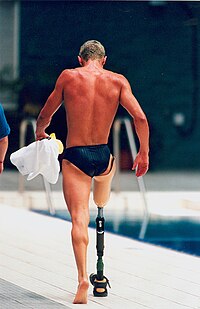
Photo from wikipedia
Abstract Approaches to improve outcomes after upper-extremity amputation remain poorly understood. Examining prosthesis-use at different levels of loss elucidates motor control challenges. Non-amputated participants completed simple and complex reach-to-grasp actions… Click to show full abstract
Abstract Approaches to improve outcomes after upper-extremity amputation remain poorly understood. Examining prosthesis-use at different levels of loss elucidates motor control challenges. Non-amputated participants completed simple and complex reach-to-grasp actions using a body-powered transradial or partial-hand prosthesis simulator. We hypothesised that increased task complexity and participants using a partial-hand device would show greater functional adaptation compared to participants using a transradial device. Partial-hand users demonstrated variable grasp postures and higher reach peak velocities in the complex, but not simple, task. All groups showed decreases in movement duration in the complex task, but only partial-hand users improved in the simple task. These behavioural changes suggest how device level and task may influence prosthesis-use, with relevance to amputation rehabilitation.
Journal Title: Journal of Motor Behavior
Year Published: 2022
Link to full text (if available)
Share on Social Media: Sign Up to like & get
recommendations!